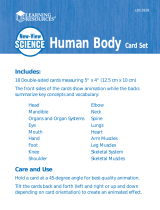Page is loading ...

Food Pyramid
Pocket Chart
LER 2493
Expand your Nutrition teaching tools with these
Learning Resources
®
products:
LER 0494 Pyramid Pals Food Group Poster
LER 0495 Healthy Play Foods (21 pc. set)
LER 0497 Magnetic Healthy Foods (34 pc. set)
LER 7221 Pretend & Play
®
Healthy Snacks Food Set
LER 7240 Food Group Bingo
© Learning Resources, Inc., Vernon Hills, IL (U.S.A.)
Learning Resources Ltd., King’s Lynn, Norfolk (U.K.)
Please retain our address for future reference.
Made in China. LRM2493-GUD
For a dealer near you, call:
(847) 573-8400 (U.S. & Int’l)
(800) 222-3909 (U.S. & Canada)
+44 (0)1553 762276 (U.K. & Europe)
This rainbow-colored Food Pyramid Pocket Chart was designed to
make teaching healthy eating habits fun! Each colored section of
the chart represents one of the food groups.
• Orange – Grains • Yellow – Oils
• Green – Vegetables • Blue – Milk
• Red – Fruits • Purple – Meat & Beans
Cards not included

The Five Basic Food Groups (Oils is considered a "non-group" because these
foods should be consumed sparingly – it is not necessary to deliberately eat
them because you obtain these nutrients by eating healthier foods from other
food groups)
Grains—This food group includes rice, cereals, pasta, oatmeal, breads,
rolls, and crackers. Foods from this group should make up a large portion
of our diets. They provide energy in the form of carbohydrates, and many
of them are valuable sources of fiber, which helps keep our bodies running
efficiently.
Vegetables—The veggie group includes roots like carrots and radishes,
stems like celery and asparagus, leaves like lettuce and cabbage, flowers
like broccoli and cauliflower, and seeds like peas and beans. Vegetables
provide us with fiber, and important vitamins and minerals.
Fruits—Colorful fruits like strawberries, oranges, grapes, pears, bananas,
watermelon, and unsweetened fruit juices make up this yummy food group.
Fruits are full of vitamins, minerals, and fiber, but some may also contain
many calories.
Oils—This "non-group" of foods contains items that should be consumed
infrequently. Candy, soda pop, butter, salad dressing, mayonnaise, cookies,
and French fries are high-calorie (and oftentimes high-fat) foods that do not
help our bodies very much. In fact, too many high-fat foods can hurt us.
The body needs a little bit of fat for energy, and to help cushion our skin
and organs, but most of the fat we need, we can get from the healthier
foods we eat. Fats are hard to digest, so they "stick around" in the body
longer than most foods, adding extra weight to our bodies, and making our
hearts work harder.
Milk—This food group includes milk, cheese, yogurt, butter, and ice
cream. These foods contain calcium, which helps keep our teeth and
bones strong and healthy. High-fat diary products like ice cream and butter
should be consumed in moderation. Consume low fat or fat-free foods
whenever possible.
Meat & Beans—This protein rich food group includes meat, poultry, fish,
dried beans, eggs, nuts, and peanut butter. Vegetarians often get protein
from soy products, like tofu and soy milk. Protein helps us grow healthy
bones, skin, hair, fingernails, and muscles. It gives us energy, and keeps
our bodies strong and healthy.
Physical Activity—In order to have a balanced life style it is essential to
make sure you stay physically active. The steps on the side of the Food
Pyramid, with the person climbing them, is a reminder of the importance of
daily physical activity.
Using the Food Pyramid Pocket Chart
Fill the pocket chart using the real photographic food cards from the Tabletop
Pocket Chart Nutrition Card Set (LER2572) or make your own cards using
heavy laminate paper. (For compatibility with the pocket chart, Learning
Resources recommends using card sizes of 2.5" x 2.5").
Discuss the different food groups and the types of foods found in each group.
Talk about your students’ favorite foods, and the kinds of healthy foods they
like to eat.
The Food Pyramid
What does the Food Pyramid tell us? Eat more foods from the wider sections!
The Food Pyramid is a visual guide to a balanced diet. Remember that a
balanced diet includes foods from every group!
For more information please visit www.mypyramid.gov
GRAINS
VEGETABLES FRUITS MILK MEAT & BEANS
/










